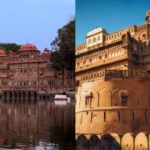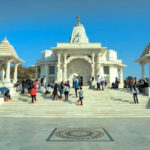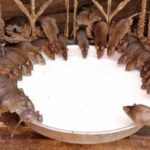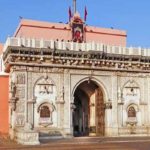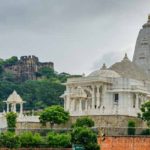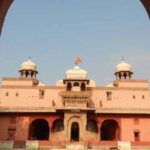Karni Mata Temple Bikaner, also known as the “Temple of Rats,” is a well-known temple in Rajasthan, India, located in Deshnoke, 30 kilometres from Bikaner.
The temple is well-known in India for housing 20,000 black rats, which are revered. These rats are known as “kabbas,” which means “holy.” Many people travel long distances to this temple to pay their respects to these rats and have their wishes granted. The appearance of these “rats” draws a large number of visitors and curious tourists from all over India to the temple.
The Mughal-style temple has a stunning marble facade with solid silver doors designed by Maharaja Ganga Singh. Many more silver doors with panels depicting different goddess stories can be found around the doorway. The goddess’s shrine is located in the inner sanctum. Karni Mata Temple Bikaner, Kundanlal Verma, a jeweller from Hyderabad, further embellished and beautified the temple in 1999. He also donated the marble carvings and the silver rats to the temple.
According to legend, once an army of 20,000 soldiers deserted in a nearby battle and fled to Deshnoke. When Mata discovered that desertion was a sin punishable by death, she spared their lives by turning them into rats. In return, the soldiers expressed their appreciation and vowed to serve the goddess indefinitely. Few white rats can be found among the black rats, which are thought to be Karni Mata Temple Bikaner and her four sons.
Another legend claims that Karni Mata’s stepson Laxman drowned while drinking water in a pond in Kapil Sarovar, Kolayat Tehsil. Mata prayed to Yama, the god of death, to save his life, which Yama initially denied but later relented, allowing Laxman and all of Mata’s male children to reincarnate as rats.
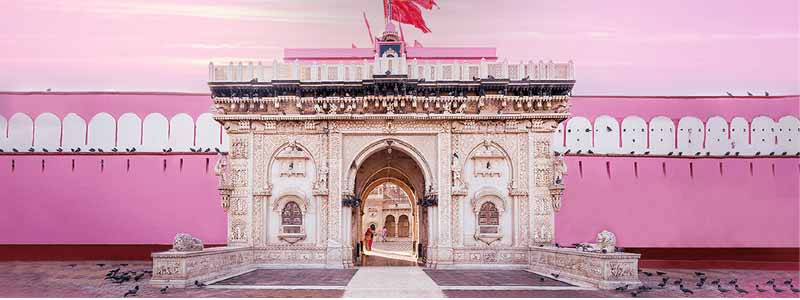
Karni Mata Temple History
Karnimata was originally the wife of DepojiCharan of Sathika village, according to legend. She later expressed her refusal to engage in matrimonial ties to her husband. He laughed at her at first, hoping she’d get over it as time went by. Instead, Karni forced her younger sister Gulab to marry him in order for him to have a proper marital life. She remained celibate for the rest of her life, with her husband’s blessing and encouragement.
Karni spent about two years in her in-laws’ village before leaving with her followers and a herd of cattle to live a nomadic life, camping at sunset. In the village of Jangloo, one such camp was built. However, a servant of the ruler of the region, Rao Kanha, refused them access to water for the citizens and cows. Karni Mata Temple Bikaner continued on her journey after announcing her follower Rao Ridmal of Chandasar as the new ruler of the village. Rao Kanha himself came to oppose her camping when she got close to Deshnok, but he died. Karni Mata came to a halt and settled down there. Depoji, her husband, died in 1454.
Rao Jodha of Jodhpur received her blessing in 1453 for conquering Ajmer, Merta, and Mandor. At Rao Jodha’s invitation, she travelled to Jodhpur in 1457 to lay the cornerstone of the fort.
During her lifetime, her follower Amara Charan built her first temple in the village of Mathania. In 1472, she arranged for Rao Bika, Rao Jodha’s fifth son, to marry Rang Kunwar, daughter of Rao Shekha of Pungal, in order to reconcile the Rathor and Bhatian families. At the behest of Rao Bika, she laid the foundation stone for the fort of Bikaner in 1485. Karniji paid a visit to the Maharaja of Jaisalmer in 1538.
She was returning to Karni Mata Temple Bikaner with her stepson Poonjar and a few other followers on March 21, that year. She asked the caravan to stop near Gadiyala and Girirajsar in the Kolayat tehsil of Bikaner district for water. She vanished there at the age of 151, according to reports.
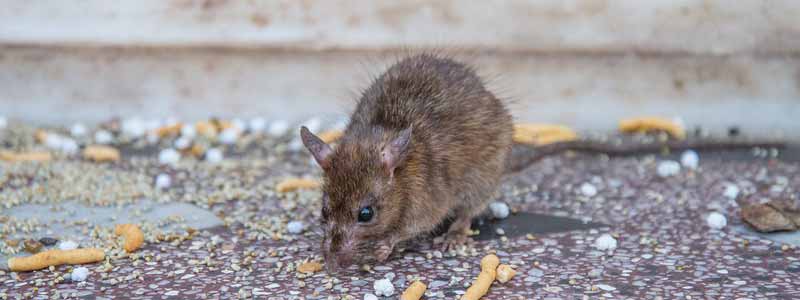
About the temple
This temple, also known as the Karni Mata Mandir, is one of Bikaner’s most popular tourist attractions. The temple is dedicated to Karni Mata, who is believed by the locals to be an incarnation of Goddess Durga, the Hindu religion’s protective Mother Goddess. In the fourteenth century, Karni Mata was a Hindu warrior sage from the Charan caste.
Karni Mata Temple Bikaner, who lived as an ascetic, was highly regarded by the locals and drew a large following. She also laid the foundation stones of the Mehrangarh and Bikaner Forts after receiving requests from the Maharajas of Jodhpur and Bikaner. Despite the fact that there are numerous temples dedicated to her, this one in Deshnoke, 30 kilometres from Bikaner, is the most well-known.
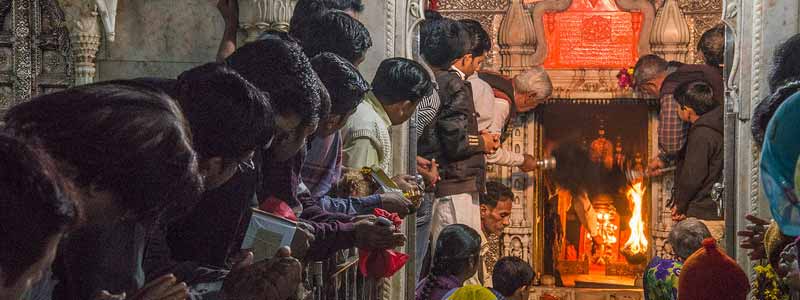
What makes the temple Unique?
The Karni Mata Mandir in Bikaner is well-known not for its location or architecture, but for the over 25,000 rats that live in and freely roam the temple grounds. These creatures can be seen emerging from crevices in the walls and ground, often passing over visitors and devotees’ feet. It is actually considered a religious thing to eat food that has been nibbled on by these rats.
People travel from all over India and the world to see this incredible sight, as well as bring milk, sweets, and other offerings for these divine beings. White rats are revered above all others because they are thought to be the incarnations of Karni Mata Temple Bikaner and her sons. Visitors go to great lengths to entice them out, often by bribing them with candy. In this temple, however, injuring or killing a rodent, even by accident, is a serious sin. As penance, those who commit this crime will have to replace the dead rat with a gold one.
Legend associated with Karni Mata Bikaner
The Karni Mata temple has interesting legends associated with it, in addition to its peculiar customs. The storey of Laxman, Karni Mata’s step-son, is the most well-known of these legends. Laxman drowns one day while attempting to drink water from the Kapil Sarovar in Kolayat Tehsil. Karni Mata Temple Bikaner, bereft of her son, prays fervently to Yama. the Hindu God of Death, who initially rejects her request to resurrect her son. He gives in to her pleadings and reincarnates not only Laxman, but all of Karni Mata’s male children as rats, moved by her sorrow and will.
Temple architecture
Maharaja Ganga Singh of Bikaner completed the construction of the Karni Mata Temple in the early twentieth century. The entire temple construction is made of marble, and its architecture is reminiscent of Mughal architecture. Strong silver doors lead to an entrance to the compound inside, adding to the allure of the attractive marble façade. The Goddess’s many legends are depicted on the panels of the silver gate.
The idol of Karni Mata Temple Bikaner, a 75 cm tall statue bearing a trident (trishul) in one hand and decorated with a crown and garlands, sits inside the temple’s inner sanctum. The Goddess’s idol is flanked on either side by that of her sisters. Kundan Lal Verma, a Hyderabad-based Karni Jeweler, completed additional enhancements to the temple in 1999. His contribution to the temple was the marble carvings and silver gates.
Important rituals and events
The Charan priests perform Mangla-ki-Arti and give bhog offerings at the Karni Mata Temple Bikaner on a regular basis. Visitors to the temple make a variety of offerings to the Goddess and the kabbas (rats). These offerings are divided into two categories: Dwar-bhent (for priests and temple workers) and Kalash-bhent (for everyone else) (utilized for temple maintenance).
Apart from this, Karni Mata temple in Bikaner is known for the Karni Mata Fair which is a bi-annual event. The time of occurrence of these fairs is during the two Navratras –
- Between March and April, from ChaitraShuklaEkam to ChaitraShuklaDashami
- Between September and October, from AshwinShukla to AshwinShuklaDashami
The footfall during these fairs accounts in thousands. The Karni Mata Temple Bikaner is open between 4 a.m. in the morning to 10 p.m. at night, everyday. There is no entry fee charged for admission within the temple.

